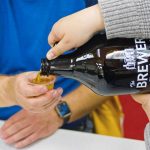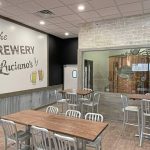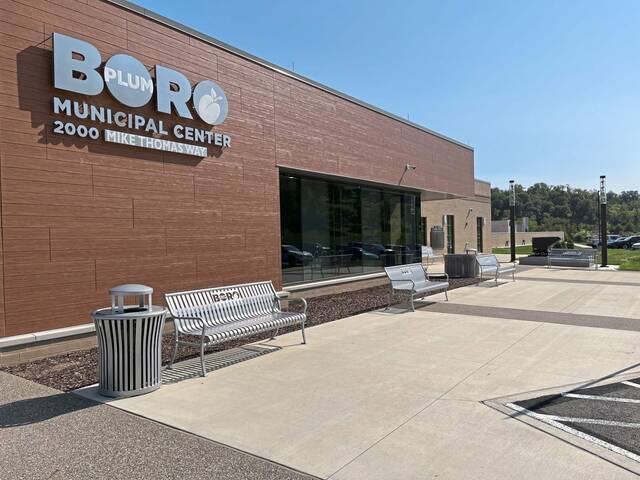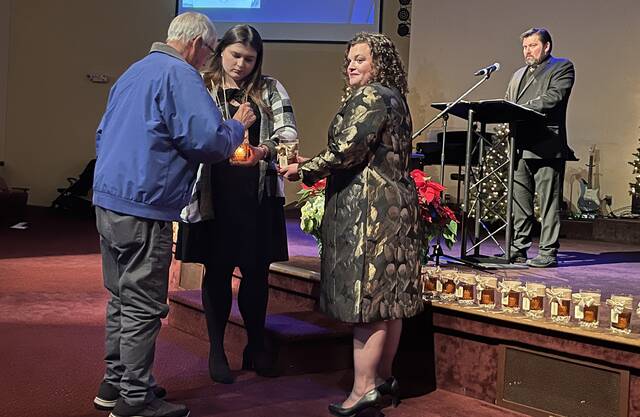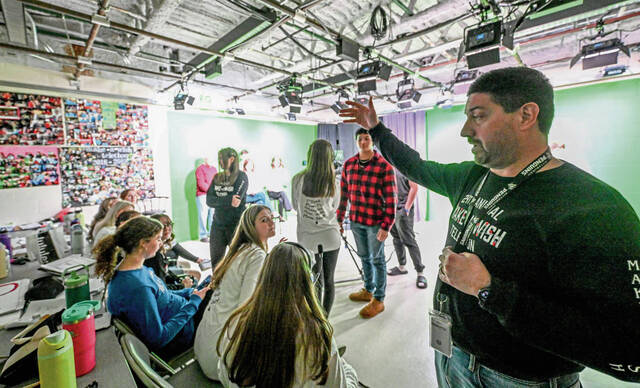That ice-cold beer you’re sipping had its share of searing temperatures on its way to your taste buds.
“Boiling, perhaps surprisingly to some folks, is extremely important in the brewing process,” Hunter Bedford told an inquisitive group gathered at Plum Borough Community Library.
The professional brewer, happily plying his trade for the Brewery at Luciano’s in Monroeville, gave a presentation at the request of library director Pam Fauls addressing the ins and outs of one of America’s best-loved beverages.
And in the spirit of what she does best, Fauls set up a table for the Oct. 13 “Books and Brews” event filled with bound volumes of everything from “Cooking With Beer” to “Beer for Dummies.”
Bedford, who does his thing at Luciano’s with former Church Brew Works brewmaster Dan Yarnell, gave a thorough primer with the added bonus of serving up samples.
First was his operation’s flagship offering, Luciano’s Italian pilsner, providing plenty of crisp, clear flavor while clocking in at a not-so-strong 4.7% alcohol by volume. And its style hails from the same country as brewery owner Dan Pasquarelli, whose family moved to the United States when he was 3.
“When we talk recipe development, we kind of come at it from a variety of different angles. Is there a particular style that we know we want to make? Is there a hole in the tap list that we want to fill? Or do we just want to try something different?” Bedford said.
“That’s kind of how Italian pilsner came about. There was a brewery in Italy that wanted to make a German-style pilsner but put their own spin on it. So they added some hops during fermentation, which is called dry hopping, if you’re familiar.”
“Books and Brews” attendees are knowledgeable now.
They also know about the difference between the two major categories of beer: lagers, of which pilsners are a subset, and ales. Well, maybe they’re still not quite up to speed on some of the finer points of the science involved, as explained by their friendly brewer:
“Ale yeast comes from the Saccharomyces cerevisiae family, and the lager yeast is Saccharomyces pastorianus.”
OK.
‘A more well-rounded, cohesive whole’
What it boils down to —we’ll return to that aspect shortly — is that lager yeast thrives at lower temperatures than ale yeast, meaning that brewers generally let lagers ferment for longer than ales.
“Our pilsner takes about 10 to 14 days, depending on how active and happy our yeast is. An ale could be as quick as three days to ferment,” Bedford said. “Once the lager is done fermenting, we store it cold in one of our tanks and just let it condition. We let the flavors kind of get to know each other. Some of the harsher flavors tone themselves down, and it becomes a more well-rounded, cohesive whole.”
Fermentation actually occurs fairly far along in the brewing process, preceded by tasks including malting, milling, mashing and something called sparging, which is extracting sugars from the barley, wheat or other base grain.
Then comes the boiling.
“It sterilizes our liquid,” Bedford said. “So if there’s any bacteria that may have gotten in on the outside of the grain, might be hiding in pipes — weird stuff can happen in a brewery — the boiling process sterilizes everything.”
Also, he explained, it helps produce beers with higher alcohol by volume.
“If you’re making a big barleywine or a really thick stout, you can just boil and boil and boil, and really concentrate that liquid down,” he said. “And then throughout the boil, we’re adding hops, which a lot of people love, for good reason. Hops add flavor. They add aroma. They add bitterness. They have natural anti-bacterial properties.”
‘Blessed to be in a good industry’
Speaking of hops adding bitterness, both are primary components of one of the most popular beer styles in the United States, India pale ale.
For “Books and Brews,” Bedford offered samples of the Brewery at Luciano’s West Coast IPA and spoke about the difference between that and its hazy, cloudy cousin from New England.
“They have different objectives in what they want beer drinkers to get out of them,” he said. “The West Coast IPA that we made is clear. It has some bitterness to it. It also has a good flavor and aroma.”
“The hazy IPA takes a different approach, taking hops and figuring out a way to get their aroma and their flavors in the beer without getting bitterness,” Bedford continued. “I think at the end of the day, for me, it’s all about, what do people like to drink? If you like to drink a hazy IPA, excellent. If you like to drink a West Coast, great. If you like to drink both, perfect, especially if I have both on tap.”
Befitting the time of year, another sample he offered was his brewery’s 5.2%-ABV Oktoberfest, a lager with a pronounced flavor of malt.
“Personally, I think it came out very nicely, very smooth,” he said, “which is the whole point of Oktoberfest.”
And for the pièce de résistance, Bedfored served Nonna’s Tiramisu Stout, a dark, malty beverage with more than a hint of Italy’s famed coffee-flavored dessert.
He and Yarnell are part of a friendly, tightly knit group of Pittsburgh-area brewers.
“I think craft beer is a unique industry in that a lot of people still kind of have a ‘rising tide lifts all boats’ mentality,” Bedford said. “We’re very blessed to be in a good industry for good people, for the most part.
“No industry is perfect, but beer’s pretty good.”






